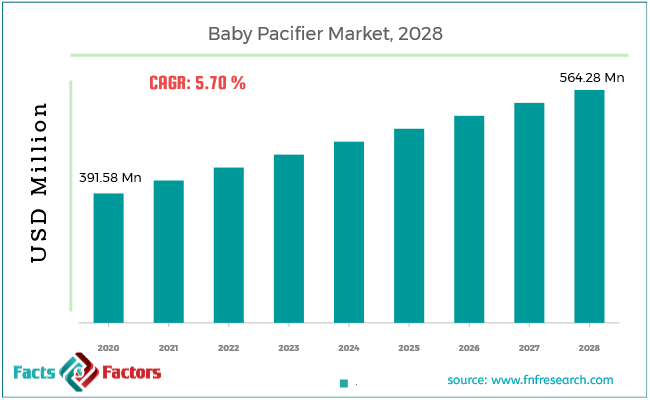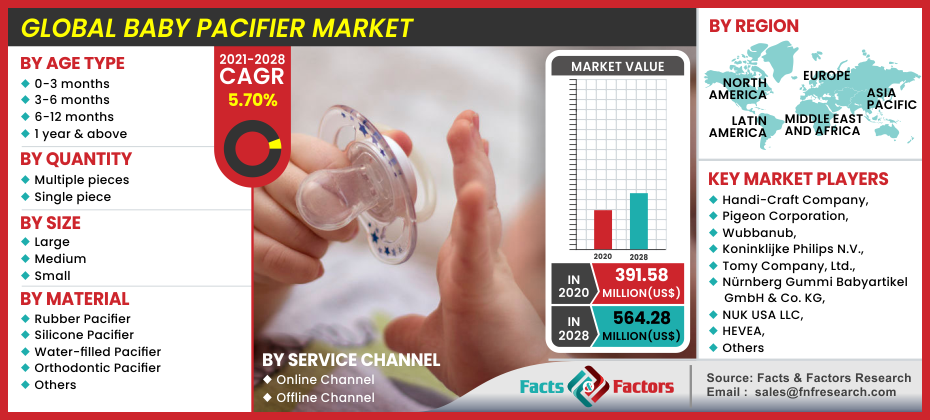Search Market Research Report
Global Baby Pacifier Market Size, Share Global Analysis Report, 2021–2028

Global Baby Pacifier Market - By Age Type (0-3 months, 3-6 months, 6-12 months, and 1 year & above), By Quantity (Multiple Pieces and Single Piece), By Size (Large, Medium, and Small), By Material (Rubber Pacifier, Silicone Pacifier, Water-Filled Pacifier, Orthodontic Pacifier, and Others), By Service Channel (Online Channel and Offline Channel), And By Region: Industry Perspective, Market Share, Size, Statistical Research, Market Intelligence, Comprehensive Analysis, Historical Trends, and Forecast 2021–2028
Industry Insights
[210+ Pages Report] According to Facts and Factors, the global baby pacifier market was worth about 391.58 (USD million) in 2020 and is predicted to grow to around 564.28 (USD million) by 2028, with a compound annual growth rate (CAGR) of around 5.70% during the forecast period. The report examines the baby pacifier market’s drivers & restraints and the impact they have on the demand during the forecast period. In addition, the report analyses global opportunities in the baby pacifier market.

 Baby Pacifier Market: Overview
Baby Pacifier Market: Overview
Baby pacifiers, also known as dummies, teethers, and soothers, are rubber or plastic pieces intended to calm and entertain babies while also preventing them from crying. They are made of materials that are soft, natural, and flexible, such as latex, silicone, and rubber. However, silicone pacifiers are thought to be more durable than latex pacifiers. They are used to relaxing babies over the first several months after birth whenever they are fussy, colicky, or have a suckling habit. Doctors also recommend baby pacifiers to prevent Sudden Infant Death Syndrome (SIDS). They are also seen as transitional objects, assisting youngsters in relieving stress and adjusting to new settings.
 Baby Pacifier Market: Growth Drivers
Baby Pacifier Market: Growth Drivers
The rise in parental disposable income, which has been associated with increased urbanization is one of the key elements boosting the demand for revenue growth of the global baby pacifier market. The use of a baby pacifier can assist in keeping babies calm and provide comfort. This actively encourages parents to buy pacifiers. Another element driving the growth of pacifiers is the increase in female employment. As a result, there is a greater demand for baby products such as feeding accessories, toys, diapers, wipes, and baby pacifiers. Furthermore, the baby pacifier market has evolved in terms of product offers throughout the years. Baby pacifier manufacturers have been planning for an innovative feature that directly addresses the requirements of target consumers.
For instance, Smilo, a company based in the United States, has introduced a new line of baby pacifiers that are fitted for the child's age and expand gently in the mouth for maximum comfort. The same technology is utilized in a variety of milk bottles, which are frequently designed to reduce air absorption to avoid gassy stomachs. As a result, inventiveness has been a crucial driver in the global baby pacifier market's overall success. However, the use of pacifiers on a regular basis may cause infection in babies, which may limit market growth over the projection period.

 Segmentation Analysis
Segmentation Analysis
The global baby pacifier market is bifurcated into type, age type, quantity, size, material, service channel, and region.
By age type, the market is divided into 0-3 months, 3-6 months, 6-12 months, and 1 year & above. Among these, the 6-12 months age group is fueling the global baby pacifier market.
By quantity, the market can be segmented into multiple pieces and single piece. Single-piece baby pacifiers have a larger market share since the product is readily available at low rates. A solitary molded piece of rubber, plastic, latex, and silicone is used to make single-piece pacifiers. Multiple-piece pacifiers are made up of different parts (for instance nipple, handle, guard, and other accessories). These pacifiers are created one at a time before being joined together to form a single pacifier.
By size, the baby pacifier market is segmented into large, medium, and small. The small-sized baby pacifiers have the highest revenue growth. By material, the baby pacifier market is segmented into rubber, silicone, water-filled, orthodontic, and others.
By service channel, the market is classified into offline and online. Company websites and e-tailer websites are types of online channels. Retail stores, specialized stores, and independent stores make up the offline channel. Offline channels dominate the baby pacifier market; however, online channels are likely to dominate the purchase scenario throughout the forecast period.
 Report Scope
Report Scope
Report Attribute |
Details |
Market Size in 2020 |
USD 391.58 Million |
Projected Market Size in 2028 |
USD 564.28 Million |
CAGR Growth Rate |
5.70% CAGR |
Base Year |
2020 |
Forecast Years |
2021-2028 |
Key Market Players |
Handi-Craft Company, Pigeon Corporation, Wubbanub, Koninklijke Philips N.V., Tomy Company, Ltd., Nürnberg Gummi Babyartikel GmbH & Co. KG, NUK USA LLC, HEVEA, Eco Viking AB, SINYA Industrial Co. Ltd, MAM Babyartikel GesmbH, Ulubulu, Handi-Craft Company, NOVATEX GmbH, BIBS, Mamajoo GmbH, Mayborn Group Ltd, Steri-Bottle, Mason Bottle, Babisil International Ltd., Munchkin, Inc., and Cherub Baby Australia, among others |
Key Segment |
By Age Type, By Quantity, By Size, By Material, By Service Channel, and By Region |
Major Regions Covered |
North America, Europe, Asia Pacific, Latin America, and the Middle East & Africa |
Purchase Options |
Request customized purchase options to meet your research needs. Explore purchase options |
 Regional Landscape
Regional Landscape
The Asia Pacific is the prominent region in the global baby pacifier market in terms of revenue growth, owing to an increase in the number of infants, an increase in the disposable income of concerned parents, and rapid urbanization. Asia has a larger infant population, with approximately 1.2 billion, representing around 25 percent of the total Asian population. Baby pacifier consumption or use has increased in nations such as Japan, India, and China. The single-piece baby pacifiers market has grown in popularity as a result of the product's easy availability at reasonable pricing for concerned parents.
 Recent Development
Recent Development
- January 2021 - My Proud Baby added new pacifiers to their ever-expanding line of inclusive baby supplies. The company has gone to great lengths to guarantee that their pacifiers are very pleasant for your baby and designed to aid in the development of gums and teeth.
 Competitive Landscape
Competitive Landscape
Some of the key players in the global baby pacifier market include :
- Handi-Craft Company
- Pigeon Corporation
- Wubbanub
- Koninklijke Philips N.V.
- Tomy Company Ltd.
- Nürnberg Gummi Babyartikel GmbH & Co. KG
- NUK USA LLC
- HEVEA
- Eco Viking AB
- SINYA Industrial Co. Ltd
- MAM Babyartikel GesmbH
- Ulubulu
- Handi-Craft Company
- NOVATEX GmbH
- BIBS
- Mamajoo GmbH
- Mayborn Group Ltd
- Steri-Bottle
- Mason Bottle
- Babisil International Ltd.
- Munchkin Inc.
- Cherub Baby Australia.
The global baby pacifier market is segmented as follows:
 By Age Type Segment Analysis
By Age Type Segment Analysis
- 0-3 months
- 3-6 months
- 6-12 months
- 1 year & above
 By Quantity Segment Analysis
By Quantity Segment Analysis
- Multiple pieces
- Single piece
 By Size Segment Analysis
By Size Segment Analysis
- Large
- Medium
- Small
 By Material Segment Analysis
By Material Segment Analysis
- Rubber Pacifier
- Silicone Pacifier
- Water-filled Pacifier
- Orthodontic Pacifier
- Others
 By Service Channel Segment Analysis
By Service Channel Segment Analysis
- Online Channel
- Offline Channel
 By Regional Segment Analysis
By Regional Segment Analysis
- North America
- The U.S.
- Canada
- Mexico
- Rest of North America
- Europe
- France
- The UK
- Spain
- Germany
- Italy
- Nordic countries
- Denmark
- Finland
- Iceland
- Sweden
- Norway
- Benelux Reunion
- Belgium
- The Netherlands
- Luxembourg
- Rest of Europe
- Asia Pacific
- China
- Japan
- India
- New Zealand
- Australia
- South Korea
- Southeast Asia
- Indonesia
- Thailand
- Malaysia
- Singapore
- Rest of Southeast Asia
- Rest of Southeast Asia
- The Middle East & Africa
- Saudi Arabia
- UAE
- Egypt
- Kuwait
- South Africa
- Rest of the Middle East & Africa
- Latin America
- Brazil
- Argentina
- Rest of Latin America
Industry Major Market Players
- Handi-Craft Company
- Pigeon Corporation
- Wubbanub
- Koninklijke Philips N.V.
- Tomy Company Ltd.
- Nürnberg Gummi Babyartikel GmbH & Co. KG
- NUK USA LLC
- HEVEA
- Eco Viking AB
- SINYA Industrial Co. Ltd
- MAM Babyartikel GesmbH
- Ulubulu
- Handi-Craft Company
- NOVATEX GmbH
- BIBS
- Mamajoo GmbH
- Mayborn Group Ltd
- Steri-Bottle
- Mason Bottle
- Babisil International Ltd.
- Munchkin Inc.
- Cherub Baby Australia.
Frequently Asked Questions

Copyright © 2025 - 2026, All Rights Reserved, Facts and Factors


